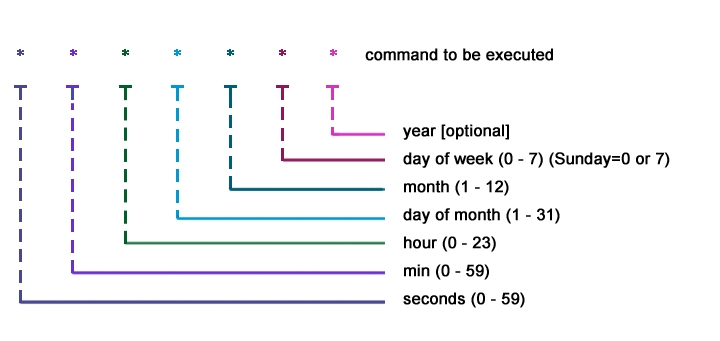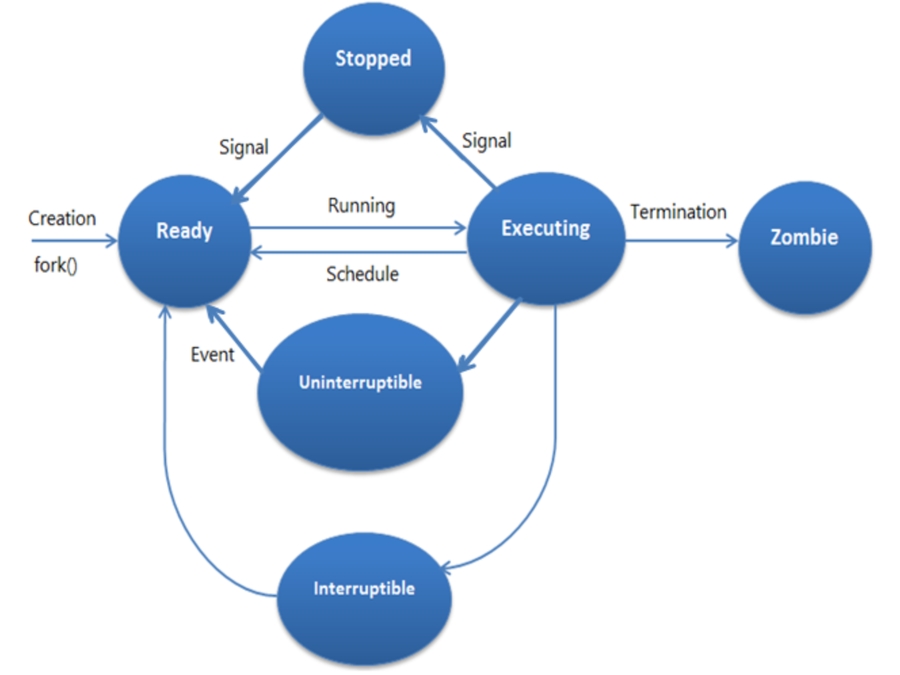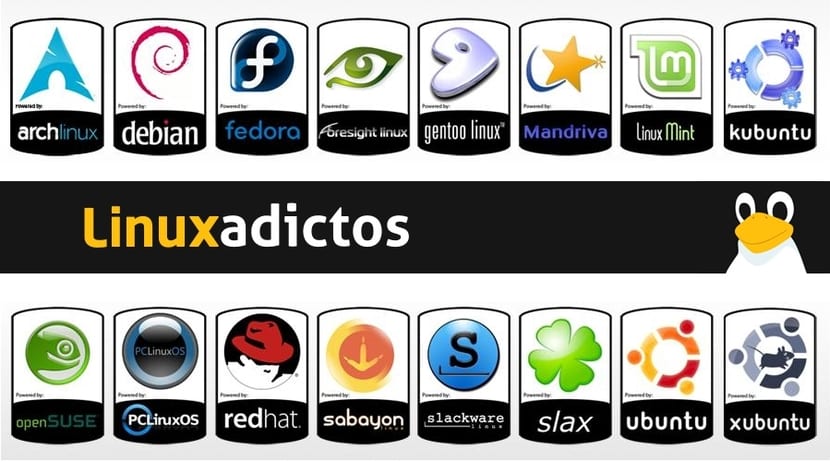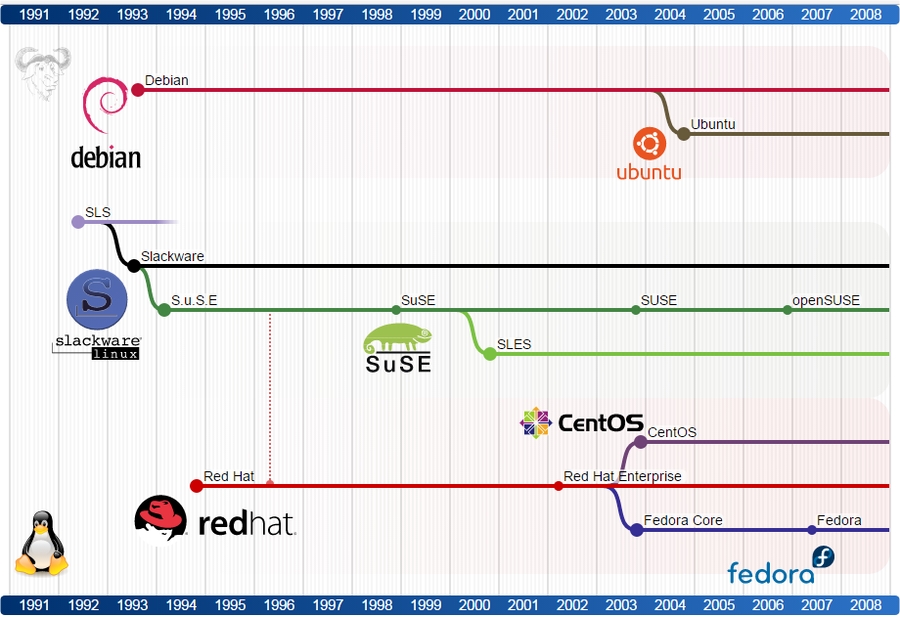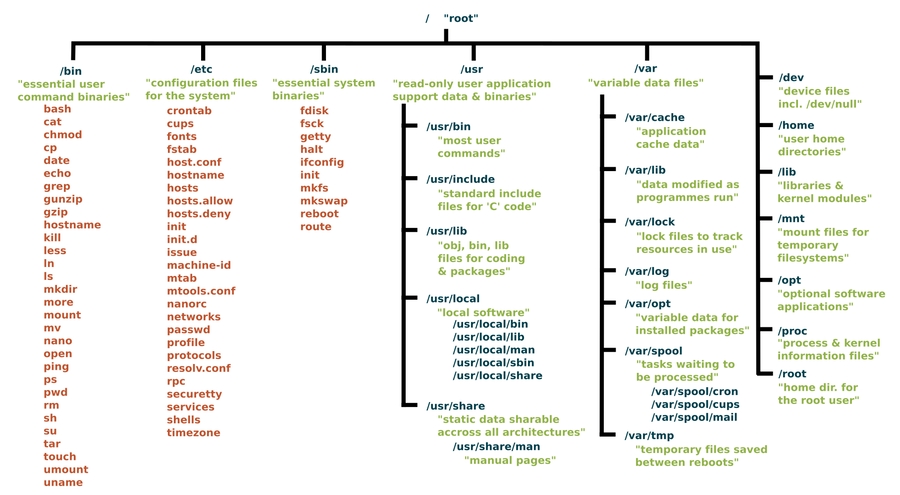Linux SysOps Handbook
An essentials notebook for the common knowledge and tasks of a Linux system admin.
Table of Content
Processes
List the current active process with their statuses, numbers, resource usage, etc. using the command ps.
Quoting man's page documentation on ps: "A different set of processes can be selected for display by using any combination of the -a, -G, -g, -p, -T, -t, -U, and -u options. If more than one of these options are given, then ps will select all processes which are matched by at least one of the given options".
The daemon systemd process starts during boot time, and remains active until the shutdown. It's the parent process for all other process in the system.
Each process contains several main parts, such as: PID, state, virtual space address (memory), threads, network and file descriptors, scheduler information, and links. Processes are controlled and respond to signals. The states that a process can transition among are depicted below:
To observe the states and other information of the processes interactively, use the top command.
To run executables as background process (job), append an ampersand to it:
To view the current jobs, and their details run job, ps j commands respectively.
To bring back a job in the foreground in the current session, and send it back use the following:
Use the command kill -l to see the available signals to send to processes, like interrupt, terminate, resume, etc.
Use killall to operate on multiple processes using their executable name. Use pkill for filtering with more options.
Finally, use pstree and pgrep to view process parent/child tree and search for processes by pattern.
User Management
The users and groups are managed in /etc/passwd and /etc/group files.
The commands to manage a user are as follows:
useraddusermoduserdel
And for groups:
groupaddgroupmodgroupdel
Each user in the system is associated with unique user id uid, and each group is associated with gid.
Use flags -g and -aG for users to replace group or append group, respectively:
To lock or unlock a user account, us the -L, -U options respectively.
To restrict service user accounts (e.g. accounts for web servers), the shell can be set to nologin:
To change a user password, use the command passwd interactively. Additionally change command sets the password policy in the system.
Use the command su - <username> to switch to the specified user. which will promote for her password. Running the command without username will switch to the root user. To avoid cases where password is not available, use sudo to switch accounts using current user password only and according to rules in /etc/sudoers directory. Use sudo -i to gain an interactive root shell.
Shell Tips and Tricks
Getting used to bash language and its fundamentals like conditions, looping, functions, etc. is recommended.
The popular files and text processing and manipulation utilities are important to master, such as:
catcprmmkdirrmdirtouchlessmoreheadtailgrepfindlocatewcsed
Use the command date to print the current date and time or others in the past and future:
The standard terminal channels in Linux are 3: stdin, stdout, and stderr where the first is for input stream and the latters for output and error streams.
By default the successful command results are outputted to stdout (equivalent to >). You can explicity redirect to stdout or stderr as follows:
To discard output stream, redirect it to the special directory /dev/null.
The standard input can be captured via redirection or file pipes:
The ssh command used to connect to servers in secure manner using OpenSSH library using public key cryptography. The configuration and known hosts are kept under /etc/ssh system-wide or in ~/.ssh/ in current user's home directory. On the other hand scp is used for secure copy on secure shell fashion.
The following list of commands are used to generate and manage ssh keys between client and server:
ssh-keygen: to generate new key pairs.ssh-copy-id: to copy the public key to the remote machines.ssh-agent: to simplify working with the private key passphrase if used.ssh-add: to cache the passphrase in the current session.
File Permissions
A file permissions are considered in three dimensions: the owner user, the owner's group, and rest of other users.
Showing the permisison of files and directories can be using ls -l, ls -ld respectively.
The basic permission types are: read (r), write (w), and execute (x) on both folders and files:
Setting the files and folders permission is done by chmod command and can be using symbols or digits.
The symbols/letter way is made for u, g, o, or a basis for the user, group, others, or all. Whereas, the digits are written for all at once in sequence for user, group, and others. Examples are below for both cases:
chown is used to change the ownership of folder/files to users or groups respectively. chgrp is a shortcut to group change only. The root or the owner are only people can change ownership and in the latter, she needs to be part of the new target group before the change.
Lastly, a fourth dimension at the start can be added to represent the special permissions of suid s, sgid s, and sticky t which control executable nature of files to be of owner users, and groups regardless of the current user. The last is to restrict deletion for only the root and owner always.
Background Services and Crons
systemctl is the command used to list, manage, and check background processes or so called daemons.
To list the available categories of daemons, run:
There are 3 types of daemons: 1. services, 2. sockets, 3. paths. Use the following to see the system's processes in each:
The states enabled and disabled indicate wether a service is lanuched on startup or not. The subcommands enable and disable can be used to control this aspect.
To view the status of a daemon use the status command or its state shortcuts:
Use the subcommands start, stop, restart, and reload, reload-or-restart to control daemons.
Additionally, use the following to list a daemon dependencies:
Finally, to resolve conflicting services making them unavailable, the mask and unmask commands can be used to point a deamons config to dev/null then back to normal respectively.
The cron daemon crond is responsible for managing the user's and system's scheduled jobs. Use the command crontab to manage jobs and their files in the user account or in the system wide /etc/crontab, /etc/cron.d/ locations.
The syntax of crontab entries is captured by the diagram below. Use the following tool to quick assistance.
An example of a cron entry that runs backup command, every day at 5:00 AM:
Linux Distros
In 1991, Linux kernel was introduced by Linus Torvalds, and combined with GNU project, which was previously created in 1983-1984 as open source OS programs and components. This formed what we call today Linux distribution, a Unix-like operating system.
Today the Linux operating system is supported on most hardware platforms. Linux works on almost every architecture from i386 to SPARC. Linux can be found on almost every type of device today, from watches, televisions, mobile phones, servers, desktops, and even vending machines.
One of the major distinction between Linux distributions is the package management part and how software is installed and managed. There are multiple package formats, and the most common ones are Debian (deb), RedHat Package Manager (RPM).
Here's a listing for the common Debian based distributions:
Debian.
Ubuntu.
Linux Mint.
Kali Linux.
And here's for RPM based distributions:
Fedora.
RedHat Enterprise Linux (RHEL).
CentOS.
openSUSE.
Logs, Monitoring, and Troubleshooting
You can monitor the system's resources usage, uptime, and sessions' load leverages over time as follows:
Use lscpu to see the system's CPU in use and other details.
The system events and processes traces are usually kept in as logs in /var/log directory. There are two categories of logs: 1. essential system logs via journald, that are wiped across boots by default (can be configured to persist). 2. rsyslog logs that persist by default and organized inside /var/log/ folder. Mainly, the logging mechanism in Linux follows the standard syslog protocol for the system's messages, events, security incidents, mailing, and jobs logs, while other programs may or may not follow syslog format identically.
As explored in section (3), use cat, head, tail commands to interactively see or follow the logs.
You can configure rsyslog service and manage it as any daemon:
On the other hand, use journalctl to view and follow the system's journald log entries, which resides in /run/log/journal.
Network Essentials
For effective work on the system network configurations and troubleshooting, it is essential to review network/internet protocols (TCP/UDP) and IPv4/IPv6 concepts (Ref.1), (Ref.2).
See the hostname of current machine or set it as below:
The host name is managed under /etc/hostname.
The host connection is either managed dynamically (DHCP) configured in /etc/resolv.conf or manually in /etc/hosts file.
The ping utiltiy helps for connectivity checking:
To see the network routing table and interfaces, use the following:
Use the command nmap for advanced network investigation and security monitor and scan.
NetworkManager is the kernel feature to manage network configurations in Linux. nmcli is the terminal utility.
System Updates and Patching
Managing the system packages varies depending on Linux distributions, but the essential parts are the same (installation, repositories, package managers, etc.). For Debian based distributions, apt is the package manager, whereas for Fedora / RHEL, yum is used.
Search for some package:
Install a package:
Update a package or all packages:
Remove a package:
Show details on a package:
List all current packages on the system:
Audit the history of package management actions:
And finally, the package source repositories can be set up and updated through the following:
Storage
Linux is formed for a unified file-system consists of all file systems provided by the hardware or virtual storage devices attached to the system. Essentially, everything in Linux is a file. It can be viewed as a reversed tree of nested directories starting from the root directory /.
Block devices are the mechanism that the kernel detects and identify raw storage devices (HDD, SSD, USBs, ..). As the name indicates, the kernel interfaces and references them by fixed-size blocks (chunks of spaces). The block devices are stored in /dev directory by the OS, and has letters naming convention such as /dev/sda, /dev/sdb, /dev/vda, and appended numbers in case of partitions /dev/sda3. The attachment of the block device into the system is done through mounting it to a directory in the system.
Two operations are essential for using block storage:
1. Partitioning:
Breaking the disk into reusable smaller units, each treated as own disk. The main partitioning methods are MBR (Master Boot Record) and GPT (GUID Partition Table). Use parted or equivalent commands to prepare partitions of block devices.
2. Formatting:
Preparing the device as a file-system to be read and write to. Many file-system formats exists like:
Ext4.XFS.Btrfs.ZFS.
Additionally, LVM concepts focus on building more extensible storage layout by grouping physical volumes (PV) into logical groups (VG), then creating logical volumes from, with possibility of extending or reduction later on.
To see the block devices and currently attached file system with mounts, and disk usage:
The lsof command lists all active processes using the block device.
The permanent mounting process rely on /etc/fstab file to determine devices to mount on the boot time.
Use the commands lsblk, mount, and unmount to check and mount filesystem devices, respectively.
Notes and Additional Resources
Use the man command to lookup the manual information on commands or topics in the system.
Additionally, the info command is the GNU documentation tool and provide more detailed materials.
Both provide shortcuts, navigation, and searching capabilities (e.g. man -K <keyword> to search across manual).
Recommended Reading List
Books:
Websites & Blogs:
License
Last updated

